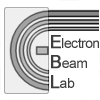Electron Accelerators
High brightness beam race-track microtron

Fig.2a: 35 MeV racetrack microtron as built
Techniques to generate short, small emittance electron bunches of several nC at energies of several MeV are being developed to drive free electron lasers, for accelerator research, to provide short laser Thomson scattering X-ray pulses, and to generate intense coherent millimeter radiation (e.g., synchrotron, transition, etc.). Typically, a high-gradient metal photocathode RF gun is synchronously excited by a high-power picosecond laser producing bunches that are compressed to sub-picosecond lengths after which their energies are increased in a linear accelerator. Generating several tens of MeV beams now requires large, expensive, energy inefficient accelerators available only at large laboratories.
Our compact, inexpensive, power parsimonious RTM, seen schematically in Fig. 2, provides an alternative when modest beam parameters are required. Here is a RF gun (1) with a heated photoelectric cathode and a gun accelerating structure, an α-magnet (4), a collimating slit (5), a laser (6), an injector accelerating structure (8), a main accelerating structure (16), and rare-earth end magnets (12) and (14). The beam is injected into the RTM through two dipole magnets (11), is focused by solenoid lens (3) and quadrupoles (7,9,13,15), is steered by coils (2,17), is extracted with magnet (18), and is registered by Faraday cup (21). By activating a dipole magnet (10) the injected beam can also be directed into the cup to estimate its bunch charge, energy, and energy spread.

Fig.2b: 35 MeV racetrack microtron Schematic
Table below lists the RTM principle parameters. RTM produces electron bunches with energies from 4.85 to 34.2 MeV having ~150 pC/bunch, ~5ps/bunch, and ~10 mm mrad normalized transverse emittance. By illuminating our RF gun photocathode by a ~500 ps or a ~8 ns excimer laser pulse we produce one or ~15 electron bunches per cycle of machine operation.
The main advantages of our machine as compared with other high brightness beam accelerators, when modest beam parameters are required are: (1) order of magnitude less consumed power for the same beam energy; (2) compactness; (3) about order of magnitude lower cost.
RTM parameters
- Injected beam: 4.85 MeV
- Energy gain per turn: 2.43MeV
- Output beam: 4.85-34.2 MeV
- Normalized emittance: 10 mm mrad
- Longitudinal emittance: 200 keV deg
- Micro pulse: 5 ps
- Pulse repetition: 1-150 Hz
- Micro charge: 150 pC
- RF frequency: 2,856 MHz
- Pulsed RF power: <3 MW
- End magnet field: 0.486 T
